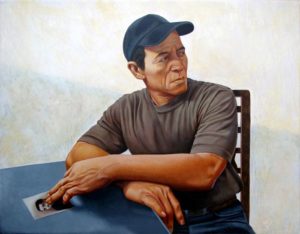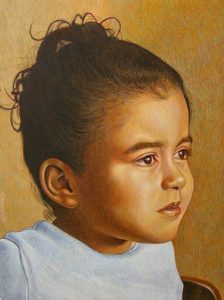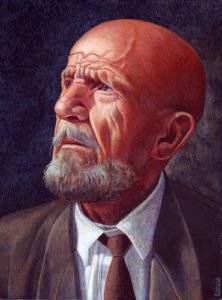Egg tempera painting is traditionally seen as a difficult medium due to it’s fast drying time. However once you get over the initial learning curve of how the paint handles it can be a very versatile medium for creating luminous works of art.

Below are a few guidelines for anyone starting out.
1. Paint Thin and Dry
- Egg tempera painting is best applied thinly and a in a dry brush manner.
- Impasto techniques are not well suited for egg tempera because it is generally brittle and the egg is not a strong binder.
- By painting thin it allows the paint to dry quickly and make a stronger bond to the traditional gesso surface.
- Painting dry is also encouraged since a wet brush tends to cause the lifting of layers already applied.
- A tell-tale sign that you are painting too wet is a noticeable dark dot at the end of all your brush strokes- this is caused by excess paint.
- Painting dry is accomplished by removing paint from the brush with a paper towel or rag.

- Artists such as Andrew Wyeth used this technique in both egg tempera and watercolors.
2. Use a Traditional Gesso Support
- Egg yolk is not a strong or flexible binder.
- As a result it is important to paint on a surface that is absorbent and rigid.
- Pre-primed canvas or panels that you buy at an art supply store will not provide the best support.
- Those type of supports use either an oil-based or acrylic-based gesso and are flexible.
- The oil-based or acrylic-based gesso are not absorbent enough to make a strong bond with the egg yolk.
- Traditional gesso is composed of gypsum(marble dust), whiting(titanium white) and rabbit skin glue. This mixture will yield a very absorbent ground which will ensure your painting does not flake off or have other unexpected results.
- For information on making your own panels visit:
- www.eggtempera.com/grounds.html.
- If you prefer to focus on painting you can purchase pre-made traditional panels from www.TrueGesso.com or www.RealGesso.com.
- I have tried both and are good options for any artist experimenting with egg tempera or the professional artist with little time on his/her hands.
3. Use Watercolor or Soft-Hair Brushes
- Egg tempera is a water-soluble paint.
- Any brush you use with watercolor should work with egg tempera.
- The king of brushes is of course the Kolinsky Sable but you can get away with a good sable blend brush that holds it’s shape nicely.
- When choosing a brush for egg tempera ensure that it can hold a point or be shaped into a chisel shape.
- Also ensure that it can be loaded easily.
- Additionally Utrecht makes some very good synthetic brushes that I have used and Koo Schadler, www.KooSchadler also recommends in her book .
- You can view them here: http://www.utrechtart.com/dsp_view_product.cfm?item=33842.
4. Great Books to Get Started
- Getting started can sometimes be a hurdle but with a good book many of the questions can be answered in one sitting. Below are some recommendations:
- Egg Tempera Painting– By Koo Schadler
http://www.kooschadler.com/thebook.htm - This is a great instructional book on egg tempera.
- Koo has done an awesome job of distilling the essentials of painting with egg tempera in a way that is easy to grasp and apply.
- The Luminous Brush– Altoon Sultan
- This book is great for an introduction to egg tempera and a quick history lesson. Altoon has provide good shots of the materials, her approach to painting and a brief look at other egg tempera artists such as George Tooker and Michael Bergt.
- The Practice of Tempera Painting– Daniel V. Thomspson
- I would be remiss if I failed to mention the definitive book on egg tempera painting – The Practice of Tempera Painting.
- This is an excellent book for any one interested in the history of traditional egg tempera application.
- Some of the information seems a little archaic but is very interesting.
- Egg Tempera Painting– By Koo Schadler
5. Websites To Visit
- To learn more about egg tempera or get connected to other artists check out the following websites:
I hope this has provided some encouragement to you as you venture into the world of egg tempera painting. If you ever have any questions feel free to email at alex@alexgarciafineart.com . Alex Garcia
Young and talented, Alex Garcia is a portrait painter born in Rio Piedras, Puerto Rico and now from San Antonio, Texas. Alex became fascinated with egg tempera after viewing an exhibit of Andrew Wyeth. The pristine imagery was unlike anything he had seen and left him mesmerized. He is inspired by Andrew Wyeth, N.C. Wyeth, Jared French, Edward Hopper, Diego Rivera to name a few.

_________________________________________________________________________
Egg tempera is one of the oldest, most versatile and durable methods of painting, dating back to preshistoric times. The artist must manufacture the paints him or herself by the process of mixing finely ground pigment, water and dilute egg yolk. We are lucky to have Alex share his knowledge and tips about this age-old medium. Thanks to Alex and others like him for keeping the traditions of egg tempera alive.
Best – Lori








I use a good powdered pigment, 1 fresh egg, a bit of water.
Just separate the egg yoke, toss it between your hands until the yoke can be handled, prick it with a needle and let the yoke run into a little jar, put in about a tablespoon of water shake.
Now the surface you paint on is important it must be smooth, i recommend rabbit skin glue gesso, on a sanded board. Then paint by dropping the egg yoke medium into 1/4 teaspoon of pigment. use a small brush and paint little overlapping X strokes. It’s really easy and fun try it out. 🙂
Don’t forget to toss the skin of the yoke away getting it into your egg medium will mess things up. Also your egg medium needs to be refrigerated. It should last you about a week without going bad.
Timothy – Thanks for sharing your knowledge about egg tempera with us. This recipe will come in handy for anyone interested in trying this beautiful medium. I just hope no one mistakes the egg mixture for scrabbled eggs while in the fridge…;-)